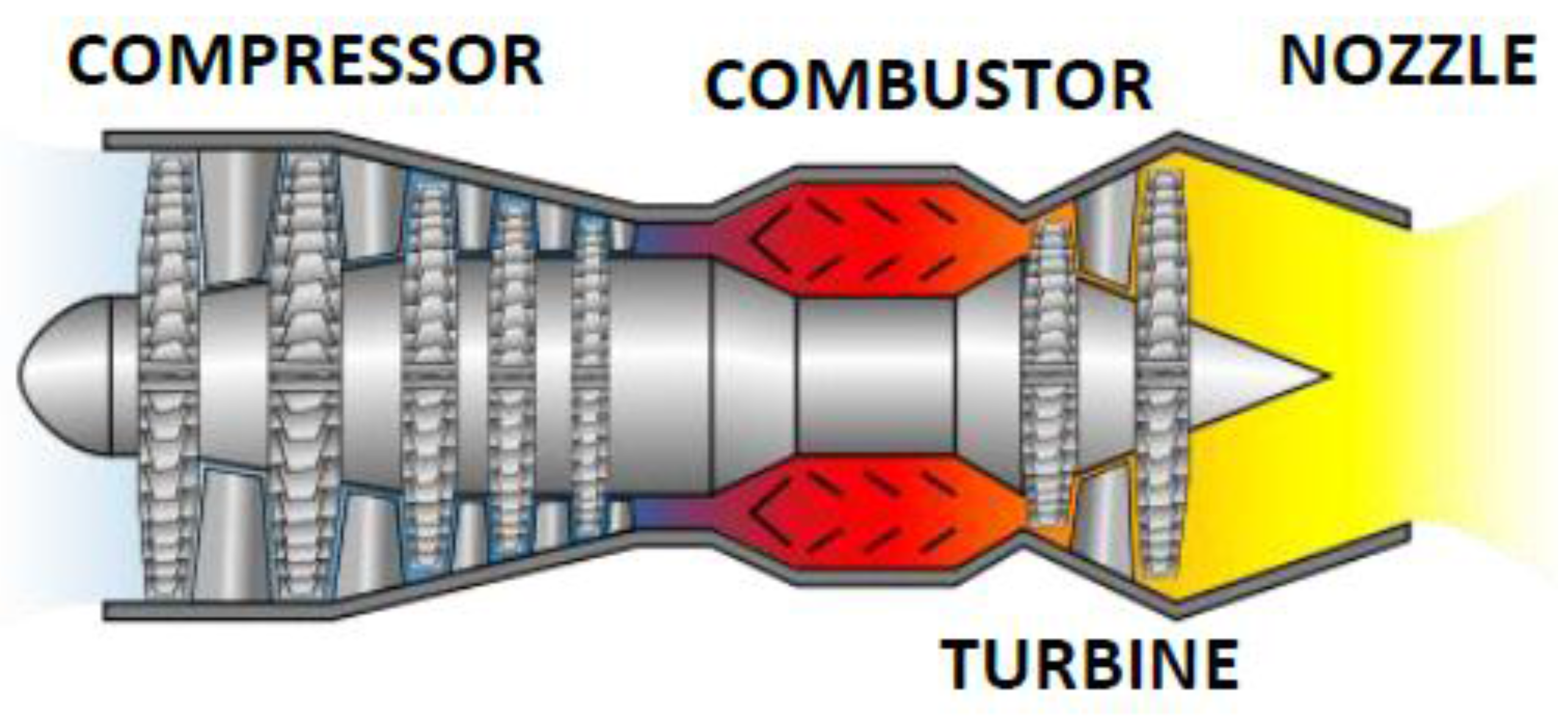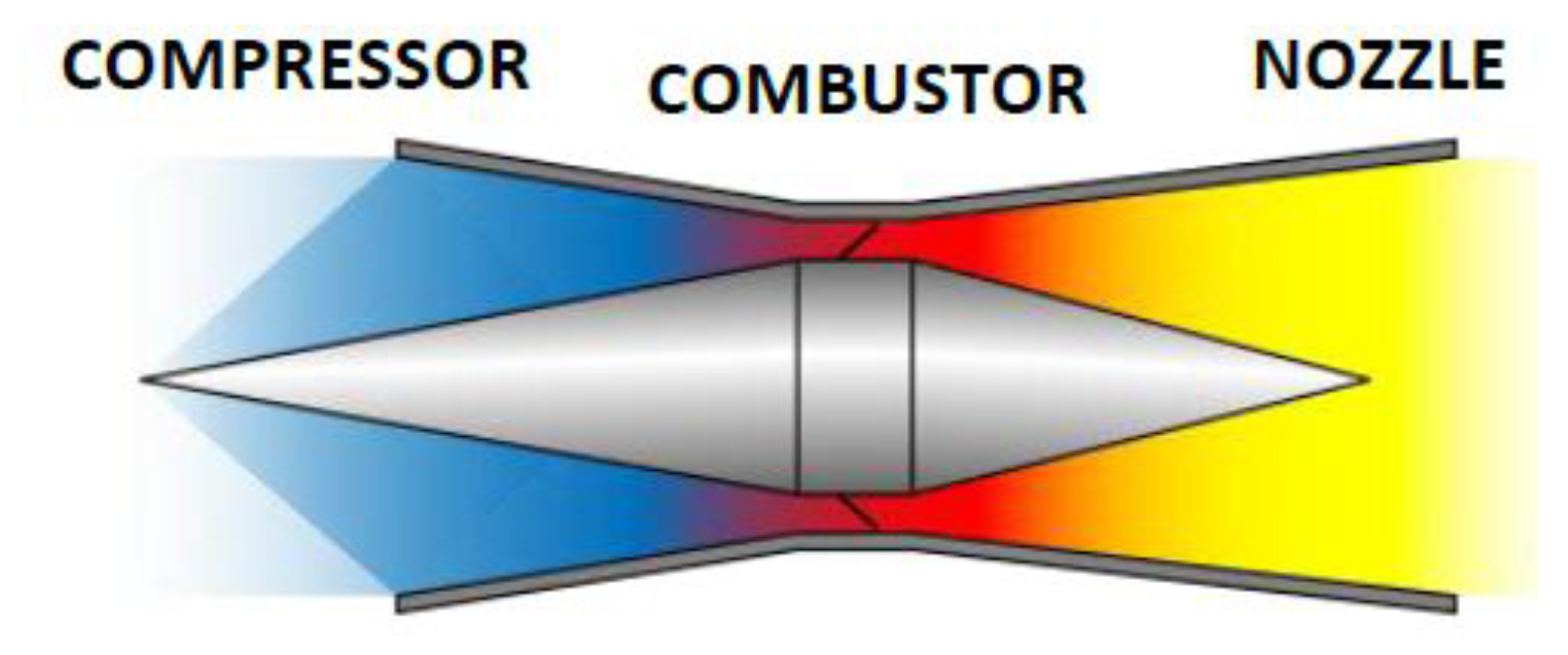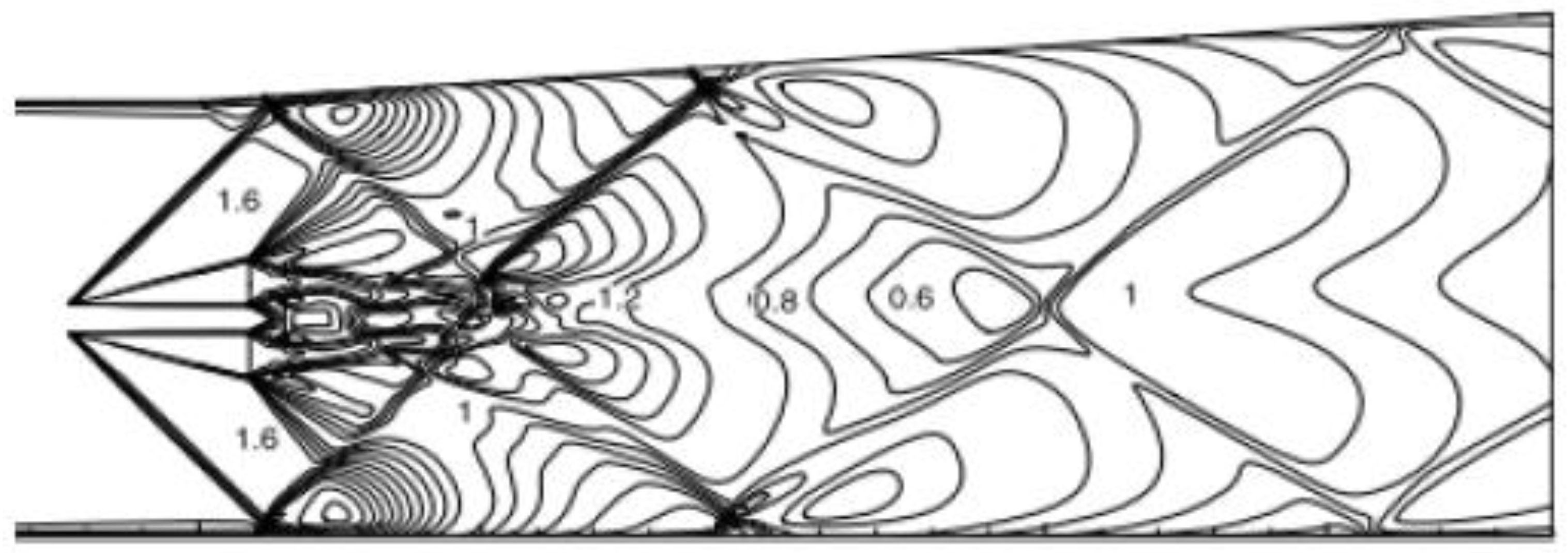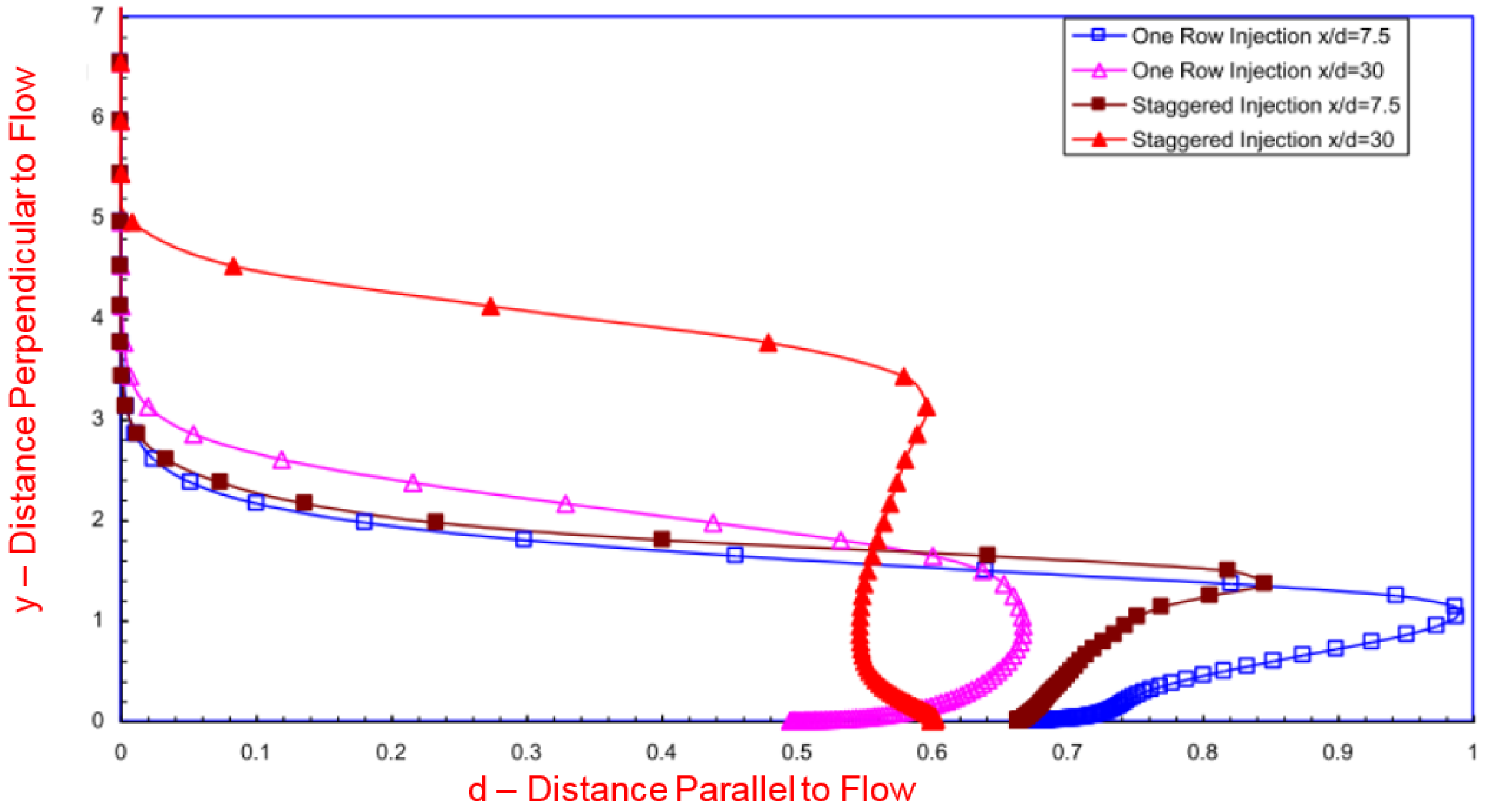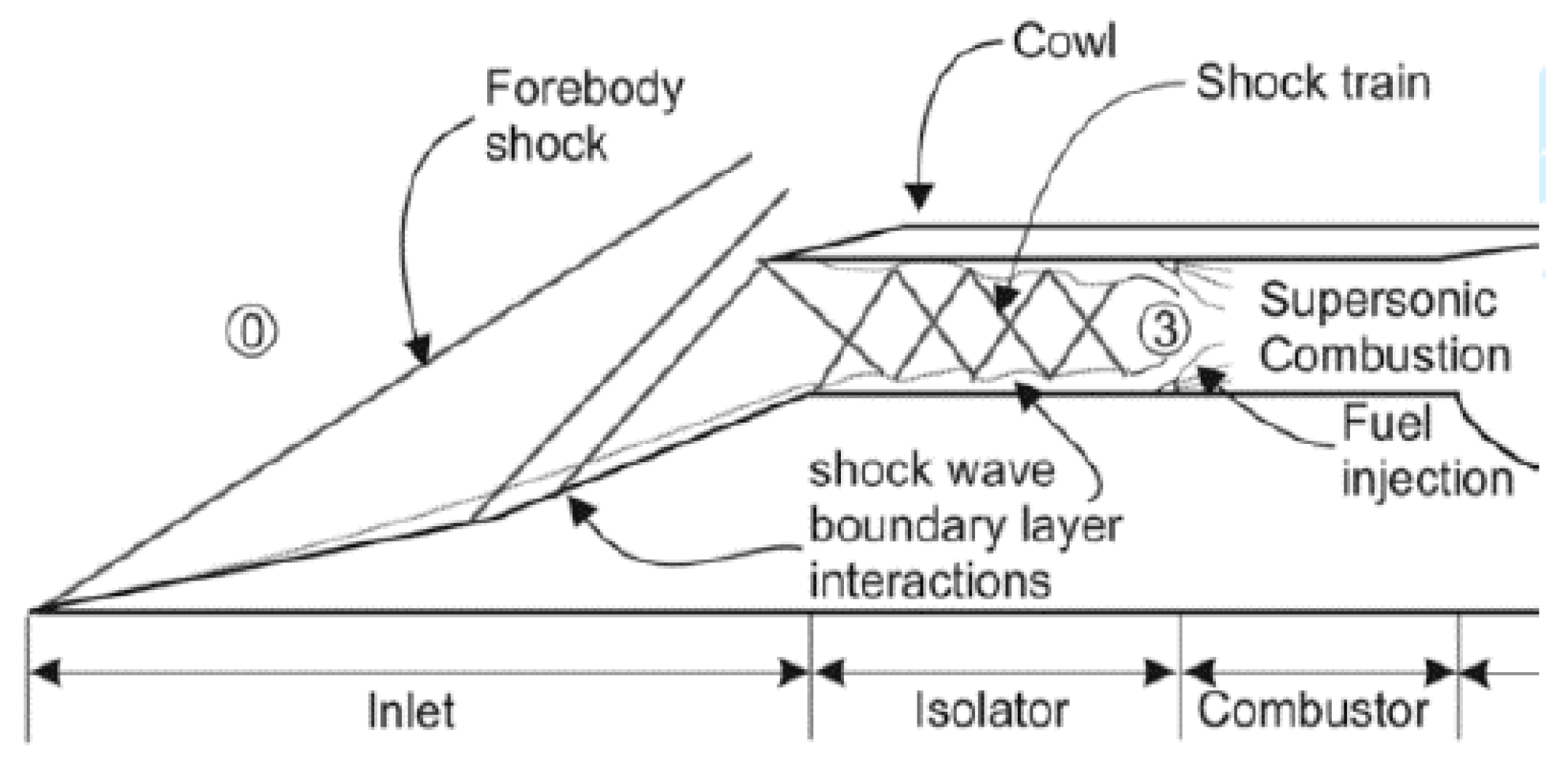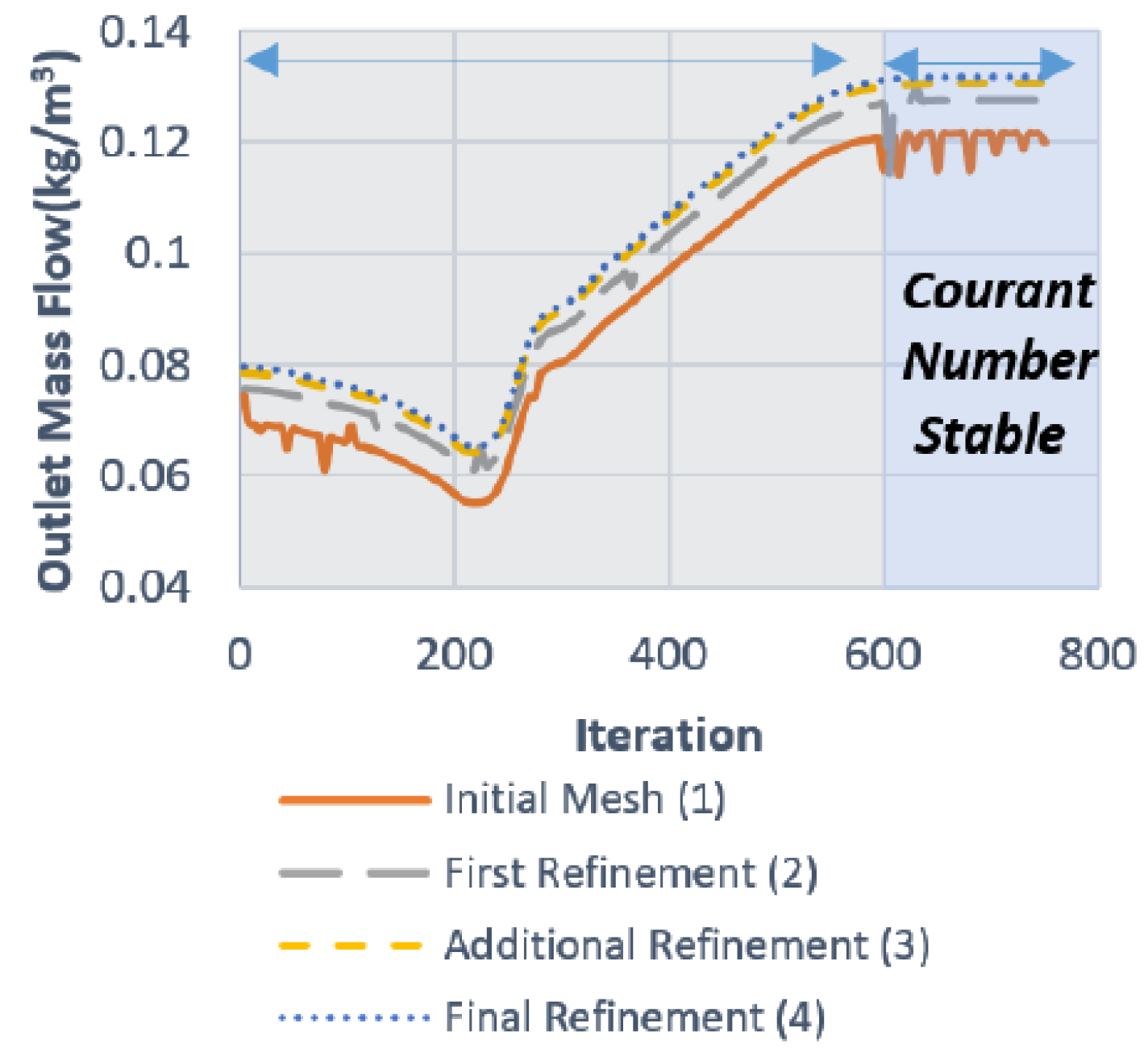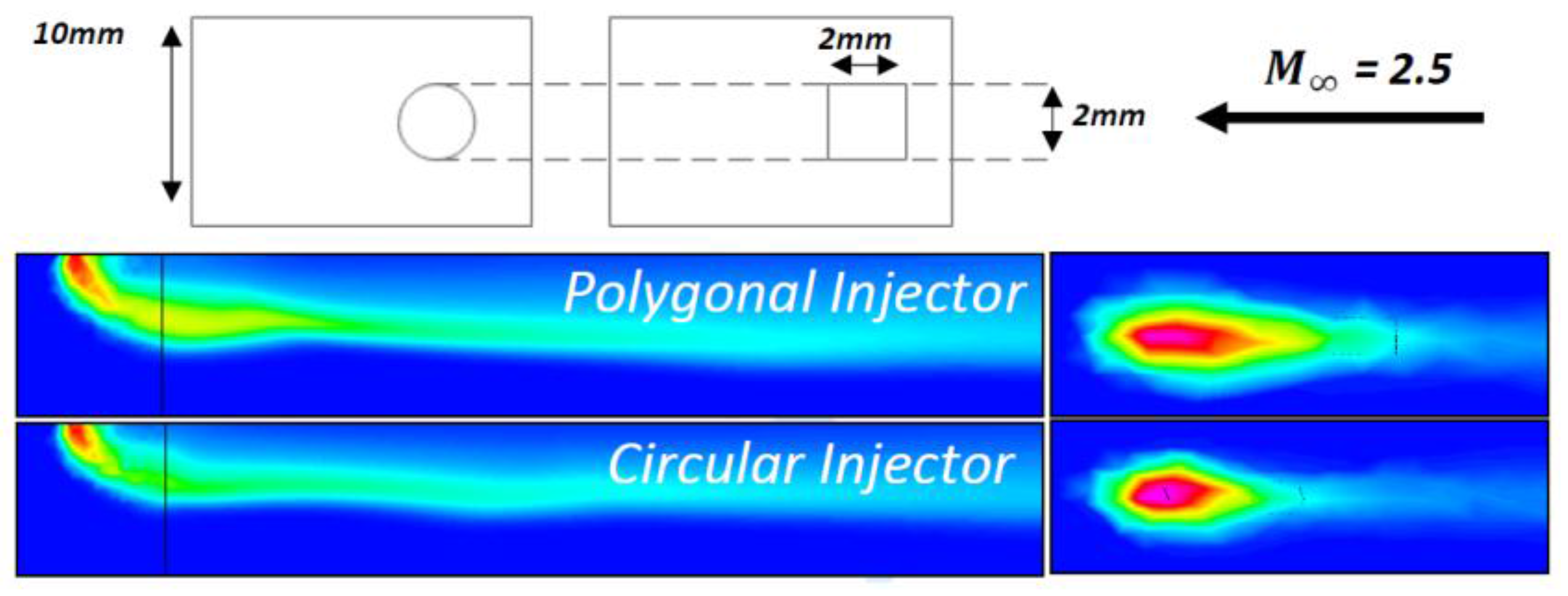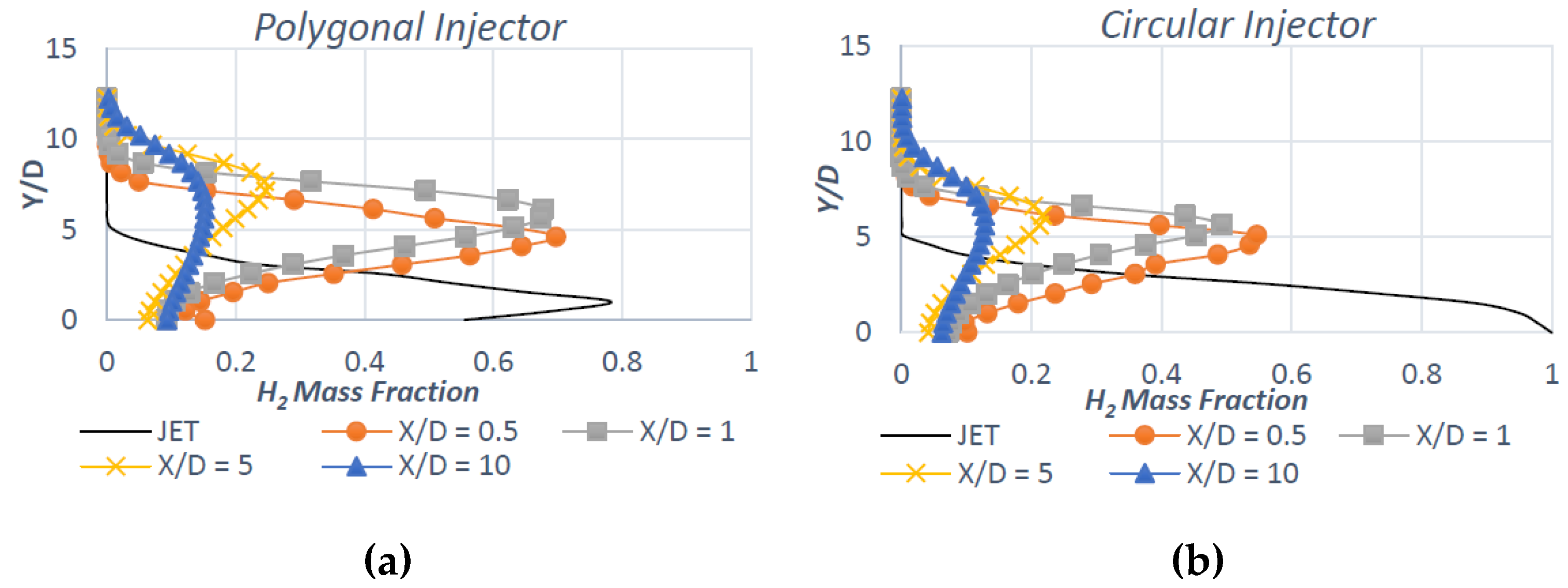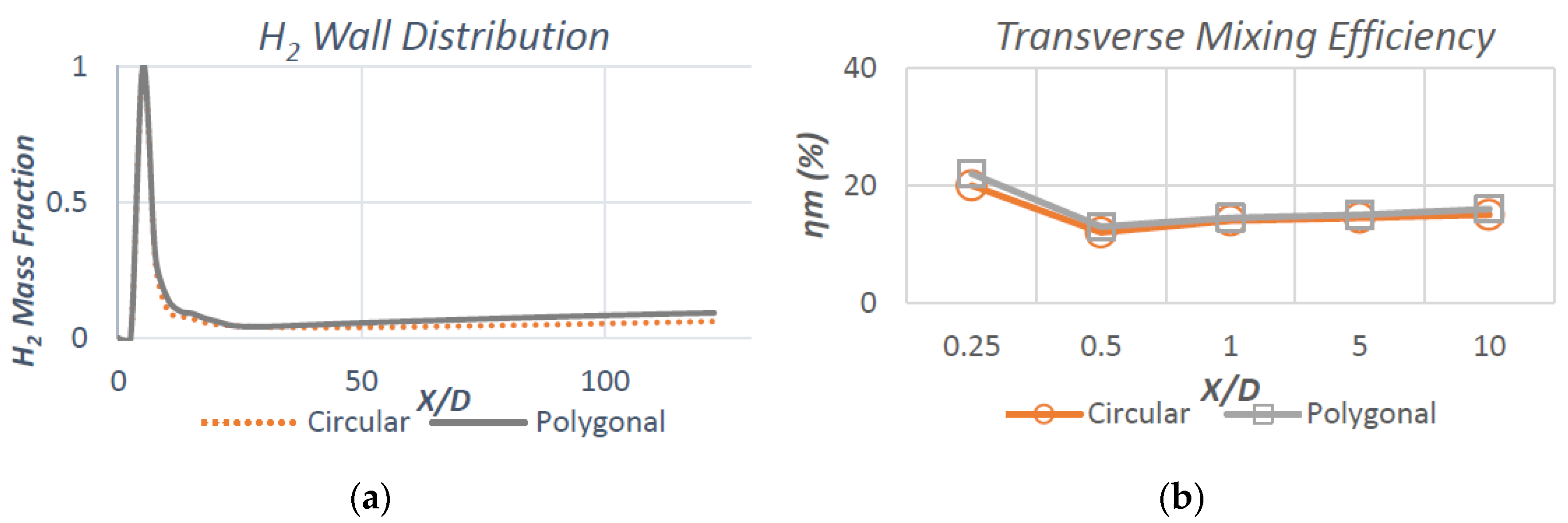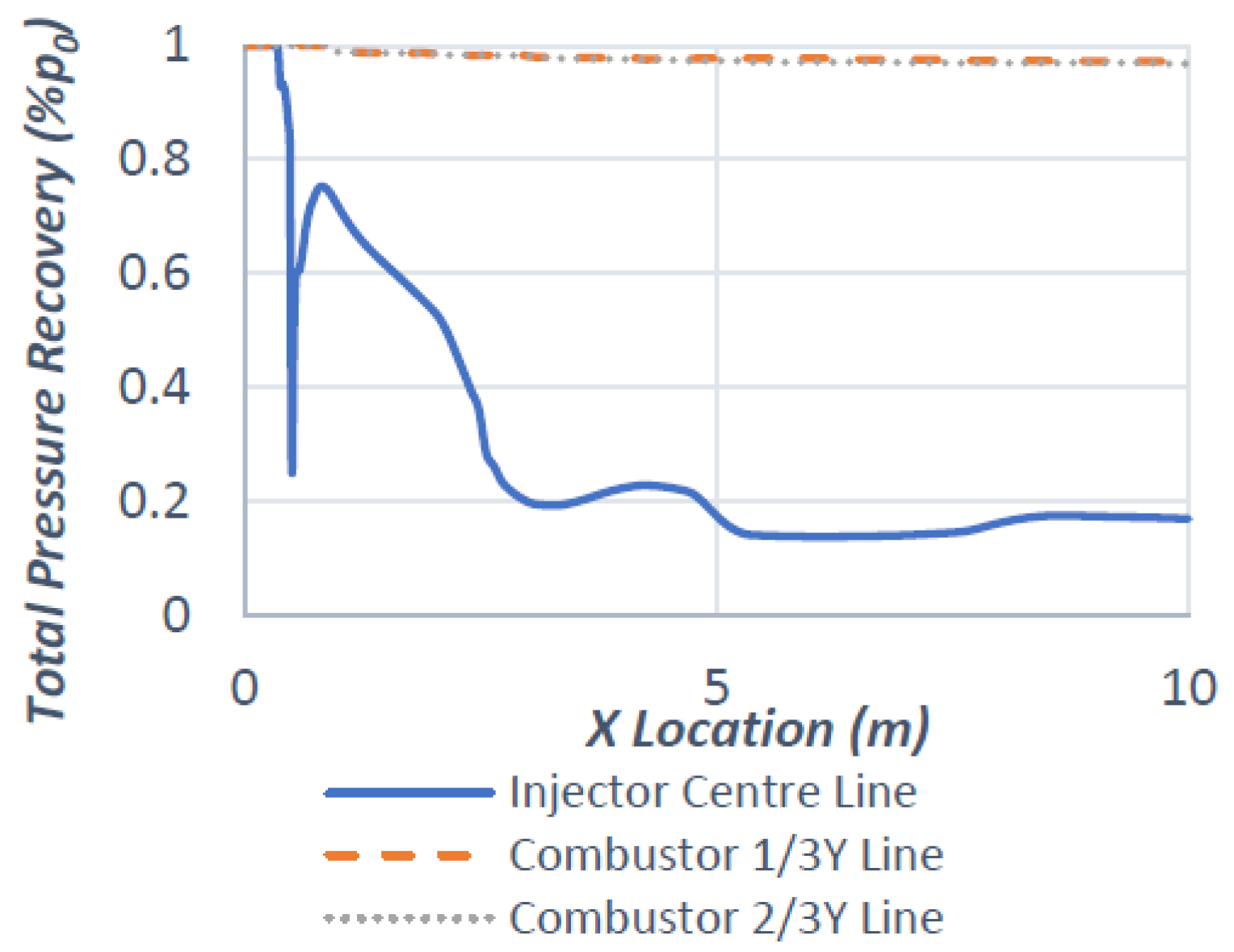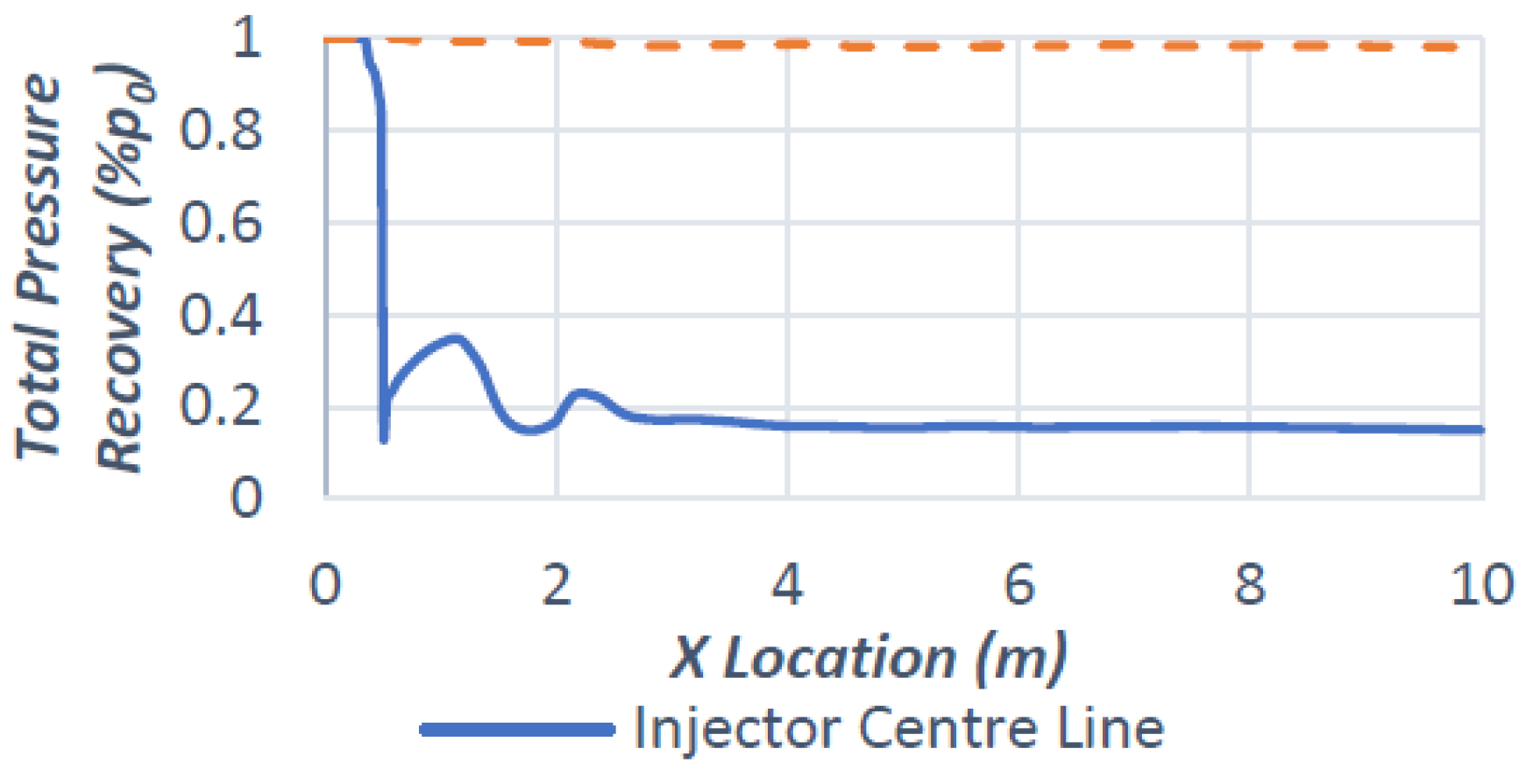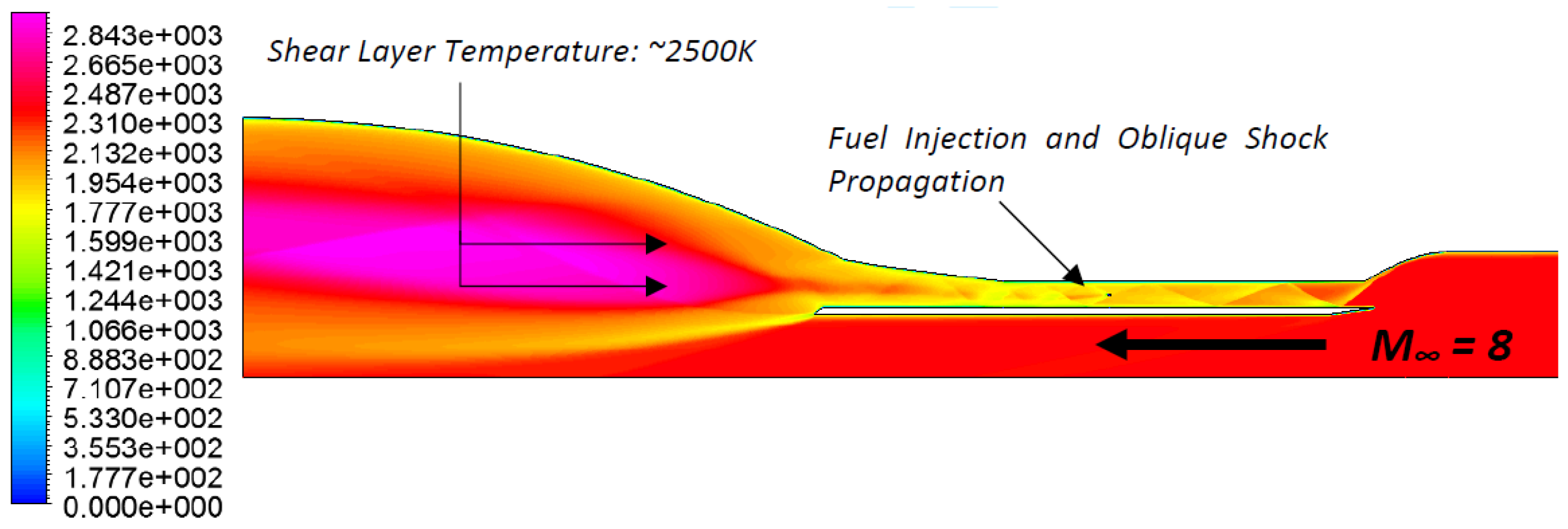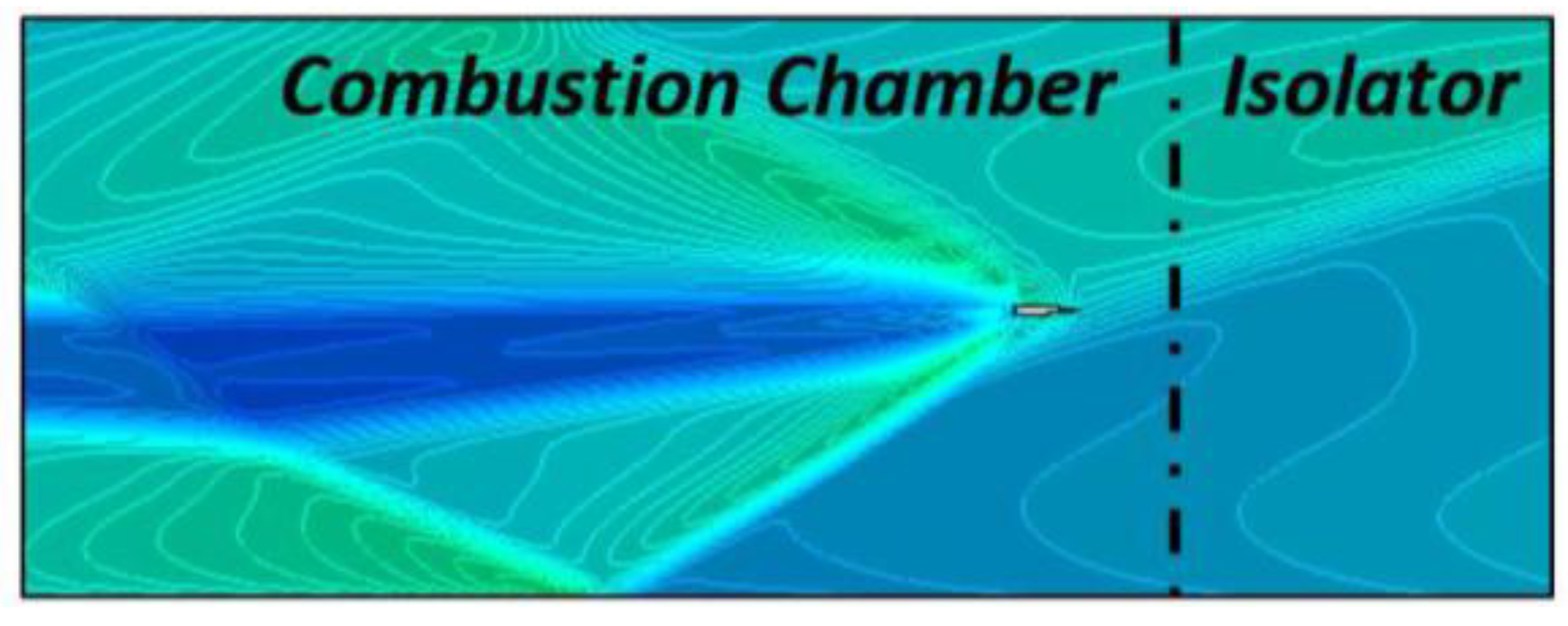Figure 1.
Turbojet engine schematic.
Figure 1.
Turbojet engine schematic.
Figure 2.
Scramjet engine schematic.
Figure 2.
Scramjet engine schematic.
Figure 3.
Transverse injection mixing study of H
2 reported in [
1], red-to-blue denoting the percentage of H
2 species in the domain.
Figure 3.
Transverse injection mixing study of H
2 reported in [
1], red-to-blue denoting the percentage of H
2 species in the domain.
Figure 4.
Shock interaction on cold flow mixing for a single strut (
left) and a twin strut (
right). Study reported in Reference [
3] (copyright ASCE library, 2015).
Figure 4.
Shock interaction on cold flow mixing for a single strut (
left) and a twin strut (
right). Study reported in Reference [
3] (copyright ASCE library, 2015).
Figure 5.
Strut injection study of temperature field and velocity vectors reported in Reference [
4].
Figure 5.
Strut injection study of temperature field and velocity vectors reported in Reference [
4].
Figure 6.
Mixing efficiency study for varied injector geometries [
6] (graph of mixing efficiency η
m vs. Downstream Location X
m ).
Figure 6.
Mixing efficiency study for varied injector geometries [
6] (graph of mixing efficiency η
m vs. Downstream Location X
m ).
Figure 7.
H
2 jet penetration (Y/D) of staggered and aligned injector arrangements [
6].
Figure 7.
H
2 jet penetration (Y/D) of staggered and aligned injector arrangements [
6].
Figure 8.
Concept hypersonic aircraft.
Figure 8.
Concept hypersonic aircraft.
Figure 9.
Hypersonic inlet forebody and shock train.
Figure 9.
Hypersonic inlet forebody and shock train.
Figure 10.
Mass flow rate convergence graph.
Figure 10.
Mass flow rate convergence graph.
Figure 11.
Cold flow comparison of DLR scramjet [
12] Schlieren (
a) to CFD test replication (
b).
Figure 11.
Cold flow comparison of DLR scramjet [
12] Schlieren (
a) to CFD test replication (
b).
Figure 12.
Reacting case comparison of DLR scramjet shadowgraph [
12] (
bottom) to CFD replicated flame temperature (K) (
top).
Figure 12.
Reacting case comparison of DLR scramjet shadowgraph [
12] (
bottom) to CFD replicated flame temperature (K) (
top).
Figure 13.
Two-dimensional (2-D) vs. three-dimensional (3-D) jet into crossflow, temperature contours (K).
Figure 13.
Two-dimensional (2-D) vs. three-dimensional (3-D) jet into crossflow, temperature contours (K).
Figure 14.
Cold flow injector performance in terms of Hydrogen mass fraction (%H Mass).
Figure 14.
Cold flow injector performance in terms of Hydrogen mass fraction (%H Mass).
Figure 15.
(a) Polygonal jet penetration height; (b) Elliptical jet penetration height.
Figure 15.
(a) Polygonal jet penetration height; (b) Elliptical jet penetration height.
Figure 16.
(a) H2 wall distribution; (b) Transverse mixing efficiency. Elliptical vs. polygonal injectors.
Figure 16.
(a) H2 wall distribution; (b) Transverse mixing efficiency. Elliptical vs. polygonal injectors.
Figure 17.
Case 2: Transverse jet penetration and wall distribution in terms of H2 mass fraction (%H Mass).
Figure 17.
Case 2: Transverse jet penetration and wall distribution in terms of H2 mass fraction (%H Mass).
Figure 18.
Bow shock extent in terms of flow field density (kg/m3). (a) Staggered; (b) Aligned.
Figure 18.
Bow shock extent in terms of flow field density (kg/m3). (a) Staggered; (b) Aligned.
Figure 19.
Total pressure loss comparison of aligned and staggered injector arrangement.
Figure 19.
Total pressure loss comparison of aligned and staggered injector arrangement.
Figure 20.
(a) H2 wall distribution; (b) Transverse mixing efficiency.
Figure 20.
(a) H2 wall distribution; (b) Transverse mixing efficiency.
Figure 21.
(a) Staggered jet penetration height; (b) Aligned jet penetration height.
Figure 21.
(a) Staggered jet penetration height; (b) Aligned jet penetration height.
Figure 22.
Flame structure of a single strut combustor in terms of static temperature (K).
Figure 22.
Flame structure of a single strut combustor in terms of static temperature (K).
Figure 23.
Total pressure loss across a single strut injection combustor.
Figure 23.
Total pressure loss across a single strut injection combustor.
Figure 24.
Shock train visualization for a single strut combustor in terms of density (kg/m3).
Figure 24.
Shock train visualization for a single strut combustor in terms of density (kg/m3).
Figure 25.
Total pressure loss across a twin strut injection combustor.
Figure 25.
Total pressure loss across a twin strut injection combustor.
Figure 26.
Shock train visualization for twin strut combustor in terms of density (kg/m3).
Figure 26.
Shock train visualization for twin strut combustor in terms of density (kg/m3).
Figure 27.
(a) Combustor total pressure loss; (b) Mass fraction of H2 remaining at outlet.
Figure 27.
(a) Combustor total pressure loss; (b) Mass fraction of H2 remaining at outlet.
Figure 28.
Velocity (in m/s) contour for transverse injection of a full scramjet engine in 2-D.
Figure 28.
Velocity (in m/s) contour for transverse injection of a full scramjet engine in 2-D.
Figure 29.
Isolator-injector shockwave interaction.
Figure 29.
Isolator-injector shockwave interaction.
Figure 30.
Velocity (in m/s) contour for single strut injection of a full scramjet engine in 2-D.
Figure 30.
Velocity (in m/s) contour for single strut injection of a full scramjet engine in 2-D.
Figure 31.
Isolator-injector shockwave interaction.
Figure 31.
Isolator-injector shockwave interaction.
Figure 32.
Velocity ( in m/s) contours for twin strut injection of a full scramjet engine in 2-D.
Figure 32.
Velocity ( in m/s) contours for twin strut injection of a full scramjet engine in 2-D.
Figure 33.
(a) Total pressure across combustor; (b) Remaining H2 mass fraction across outlet.
Figure 33.
(a) Total pressure across combustor; (b) Remaining H2 mass fraction across outlet.
Figure 34.
Integrated 3-D scramjet, temperature (K) contour planes.
Figure 34.
Integrated 3-D scramjet, temperature (K) contour planes.
Figure 35.
Integrated 3-D scramjet, H2 injector render.
Figure 35.
Integrated 3-D scramjet, H2 injector render.
Figure 36.
Integrated 3-D scramjet, velocity contour (m/s) planes.
Figure 36.
Integrated 3-D scramjet, velocity contour (m/s) planes.
Table 1.
Concept aircraft fundamental flight profile.
Table 1.
Concept aircraft fundamental flight profile.
| Phase | Altitude (ft) | Mach | Turbojet | Ramjet | Scramjet |
|---|
| Take-off and Initial Climb | 0–1500 | 0–1 | | | |
| Climb 1 | 1500–40,000 | 1–2 | | | |
| Climb 2 | 40,000–60,000 | 2–4 | | | |
| Climb 3 | 60,000–100,000 | 4–7 | | | |
| Cruise | 100,000 | 8 | | | |
| | Single Operation | | Dual Operation | | No Operation |
Table 2.
Scramjet inlet performance data.
Table 2.
Scramjet inlet performance data.
| Scramjet Inlet Performance |
|---|
| Length | 4m (Ramps) 10 m (Isolator) |
| Area Ratio | 0.5 |
| Compression Ratio | 50 (Inlet) 26 (Isolator) |
| Exit Mach No. | 2.5 |
Table 3.
Scramjet nozzle performance data.
Table 3.
Scramjet nozzle performance data.
| Scramjet Nozzle Performance |
|---|
| Length | 30 m |
| Area Ratio | 4.5 |
| Expansion Pressure Ratio | 4.5 |
| Expected Entry Mach No. | 2.5–3.0 |
Table 4.
CFD solution methods and boundary conditions.
Table 4.
CFD solution methods and boundary conditions.
| Solution Methods | Boundary Conditions |
|---|
| Turbulence Model | k-ε Standard with Compressibility | Combustor Entrance | Pressure Inlet (Fixed Total/Static/Mach Number) |
| Chemistry | Species Transport-Volumetric Finite-Rate Reaction | Combustor Exit | Pressure Outlet |
| Discretisation | Implicit Density-based | Injector | Pressure Inlet (Fixed Total/Static/Mach Number) |
| Courant-Friedrich’s | Solution Steering, FMG Initialisation | Wall | Simulation of Final Injection Isothermal |
Table 5.
Injection system cases investigated.
Table 5.
Injection system cases investigated.
| Injection System Investigation for Mach 8 Fuelled Scramjet Combustor |
|---|
| Validation | Replication of DLR Experimental Testing for CFD Configuration Validation | Case 4 | Performance of Single Strut Injection |
| Case 1 | Performance of Elliptical vs. Polygonal Injector Geometries | Case 5 | Performance of Twin Strut Injection |
| Case 2 | Performance of Staggered vs. Aligned Injector Arrangement | Case 6 | Simulaton of Integrated Scramjet Combustion |
| Case 3 | Performance of Final Transverse Method | Case 7 | Simulation of Final Injection Configuration Scramjet Integration |
| Repeated for both 2-D and 3-D |
Table 6.
Injector case performance data.
Table 6.
Injector case performance data.
| | | | | TRANSVERSE |
|---|
| Case | | H2 Outlet | | | Y/D |
|---|
| Elliptical | / | 0.12 | 0.88 | 0.15 | 5 |
| Polygonal | / | 0.15 | 0.85 | 0.16 | 6 |
| Aligned | 70 | 0.22 | 0.76 | 0.25 | 15 |
| Staggered | 75 | 0.42 | 0.58 | 0.20 | 5 |
| Single Strut | 97 | 0.25 | 0.75 | N/A |
| Twin Strut | 96 | 0.28 | 0.72 |
Table 7.
2-D scramjet performance data for varied injector configurations.
Table 7.
2-D scramjet performance data for varied injector configurations.
| Case | | H2 Outlet | | Peak u (m/s) | Peak Thrust (kN) |
|---|
| Transverse | ~67 | 0.26 | 0.74 | | |
| Single Strut | ~87 | 0.08 | 0.92 | | |
| Twin Strut | ~80 | 0.02 | 0.98 | 2850 | 1873 |
Table 8.
3-D scramjet integration final setup.
Table 8.
3-D scramjet integration final setup.
| Struts | Injectors | Injector Diameter (mm) | Injector Spacing (mm) | Equivalence Ratio | Mesh Elements (mil) |
|---|
| 2 | 100 | 5 | 50 | 0.6 | 4.5 |
